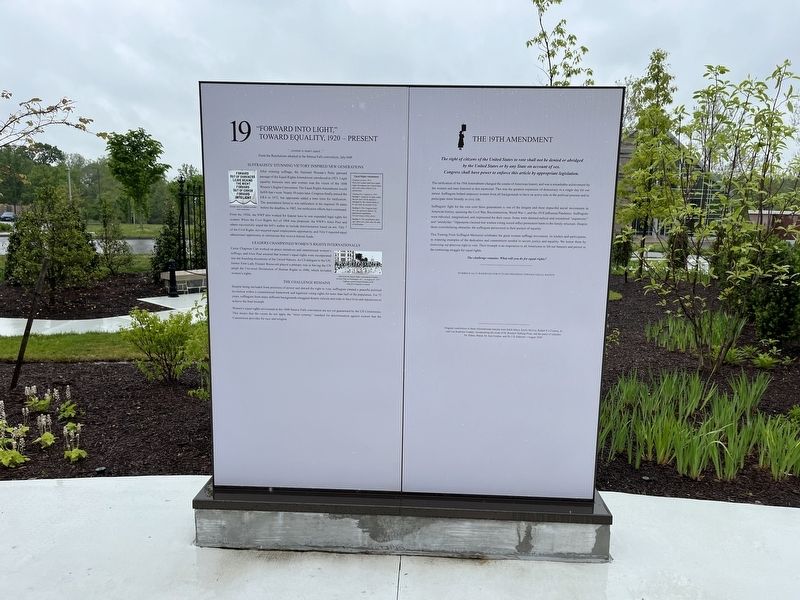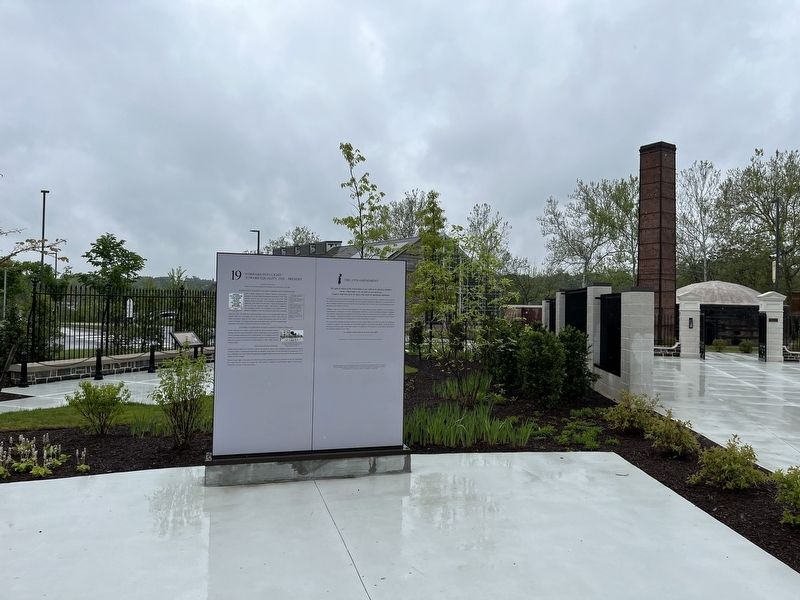Lorton in Fairfax County, Virginia — The American South (Mid-Atlantic)
"Forward Into Light," Toward Equality, 1920 - Present / The 19th Amendment

Photographed By Devry Becker Jones (CC0), May 6, 2022
1. "Forward Into Light," Toward Equality, 1920 - Present / The 19th Amendment Marker
"Forward Into Light," Toward Equality, 1920 - Present
"…woman is man's equal…"
From the Resolutions adopted at the Seneca Falls convention, July 1848
Suffragists' Stunning Victory Inspired New Generations
After winning suffrage, the National Woman's Party pursued passage of the Equal Rights Amendment introduced in 1923. Legal equality between men and women was the vision of the 1848 Women's Rights Convention. The Equal Rights Amendment would fulfill that vision. Nearly 50 years later, Congress finally passed the ERA in 1972, but opponents added a time limit for ratification. The amendment failed to win ratification in the required 38 states before the deadline in 1982, but ratification efforts have continued.
From the 1920s, the NWP also worked for federal laws to win expanded legal rights for women. When the Civil Rights Act of 1964 was proposed, the NWP's Alice Paul and others successfully urged the bill's author to include discrimination based on sex. Title 7 of the Civil Rights Act required equal employment opportunity, and Title 9 required equal educational opportunity at institutions that receive federal funds.
Leaders Championed Women's Rights Internationally
Carrie Chapman Catt worked on peace initiatives and international women's suffrage, and Alice Paul ensured that women's equal rights were incorporated into the founding documents of the United Nations. As US delegate to the UN, former First Lady Eleanor Roosevelt played a primary role in having the UN adopt the Universal Declaration of Human Rights in 1948, which included women's rights.
The Challenge Remains
Despite being excluded from positions of power and denied the right to vote, suffragists created a peaceful political revolution within a constitutional framework and legalized voting rights for more than half of the population. For 72 years, suffragists from many different backgrounds struggled despite ridicule and risks to their lives and reputations to achieve the final triumph.
Women's equal rights envisioned at the 1848 Seneca Falls convention are not yet guaranteed by the US Constitution. This means that the courts do not apply the "strict scrutiny" standard for discrimination against women that the Constitution provides for race and religion.
The 19th Amendment
The right of citizens of the United States to vote shall not be denied or abridged by the United States or by any State on account of sex. Congress shall have power to enforce this article by appropriate legislation.
The ratification of the 19th Amendment

Photographed By Devry Becker Jones (CC0), May 6, 2022
2. "Forward Into Light," Toward Equality, 1920 - Present / The 19th Amendment Marker
Suffragists' fight for the vote over three generations is one of the longest and most impactful social movements in American history, spanning the Civil War, Reconstruction, World War I, and the 1918 Influenza Pandemic. Suffragists were ridiculed, marginalized, and imprisoned for their cause. Some were deemed radical and considered "unpatriotic" and "unladylike." Opponents claimed that women voting would inflict permanent harm to the family structure. Despite these overwhelming obstacles, the suffragists persevered in their pursuit of equality.
This Turning Point Memorial celebrates the great woman suffrage movement, its leaders and participants, as inspiring examples of the education and commitment needed to secure justice and equality. We honor them by exercising our precious right to vote. Their triumph is an inspiration to all Americans to lift our banners and persist in the continuing struggle for equal rights.
[Captions:]
Symbolically reserved for future progress toward equal rights
Original contributors to these informational stations were Edith Mayo, Emily McCoy, Robert P.J. Cooney, Jr., and Lisa Kathleen Graddy, incorporating the work of Dr. Rosalyn Terborg-Penn; and the panel of scholars: Dr. Sidney Bland, Dr. Ann Gordon, and Dr. J.D. Zahniser. • August 2020
Erected 2021 by Turning Point Suffragist Memorial Association. (Marker Number 19.)
Topics and series. This historical marker is listed in these topic lists: Civil Rights • Government & Politics • Women. In addition, it is included in the Eleanor Roosevelt series list. A significant historical month for this entry is July 1848.
Location. 38° 40.927′ N, 77° 15.172′ W. Marker is in Lorton, Virginia, in Fairfax County. Marker is on Lorton Road, one mile south of Ox Road (Virginia Route 123), on the left when traveling east. Touch for map. Marker is at or near this postal address: 9751 Ox Rd, Lorton VA 22079, United States of America. Touch for directions.
Other nearby markers. At least 8 other markers are within walking distance of this marker. Hard-Fought Ratification Campaigns in the States / The Continued Struggle for Voting Rights (here, next to this marker); Victories in 1917 / Suffragists Demonstrated Until Congress Passed the 19th Amendment (a few steps from this marker); Suffragist Commemorative Wall (a few steps from this marker); "Forward Out of Darkness" / Issuing a Call for Women's Rights (a few steps from this marker); Silent for Suffrage (a few steps from this marker); a different marker also named Suffragist Commemorative Wall (a few steps from this marker); Worsening Conditions / Violent Repression (a few steps from this marker); Building a Political Movement / Testing Constitutional Amendments (a few steps from this marker). Touch for a list and map of all markers in Lorton.
Additional commentary.
1. About Eleanor Roosevelt
Eleanor Roosevelt is widely believed to have been lesbian or bisexual, based on current constructions of those terms. The LGBTQ+ categories are selected here because complete histories of LGBTQ+ individuals have been obscured over time in order to hide those details.
— Submitted May 7, 2022, by Devry Becker Jones of Washington, District of Columbia.
Additional keywords. human rights; UDHR; LGBT; LGBT+; 🏳️🌈
Credits. This page was last revised on May 7, 2022. It was originally submitted on May 7, 2022, by Devry Becker Jones of Washington, District of Columbia. This page has been viewed 124 times since then and 19 times this year. Photos: 1, 2. submitted on May 7, 2022, by Devry Becker Jones of Washington, District of Columbia.